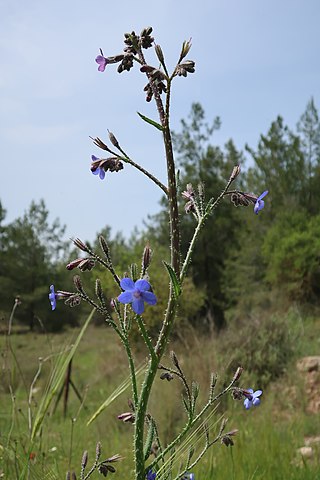
Asphodelus is a genus of mainly perennial flowering plants in the asphodel family Asphodelaceae that was first described by Carl Linnaeus in 1753. The genus was formerly included in the lily family (Liliaceae). The genus is native to temperate Europe, the Mediterranean, Africa, the Middle East, and the Indian Subcontinent, and some species have been introduced to, and are now naturalized in, other places such as New Zealand, Australia, Mexico and southwestern United States. Many asphodels are popular garden plants, which grow in well-drained soils with abundant natural light.

Anacyclus is a genus of plants in the family Asteraceae described by Linnaeus in 1753. Annuals or herbaceous perennials, they are cultivated for their fern-like leaves on creeping, radiating stems and daisy-like flowers. They are frost-hardy but may tolerate winter temperatures below −5 °C (23 °F) if grown in well-drained soil.

Asphodelaceae is a family of flowering plants in the order Asparagales. Such a family has been recognized by most taxonomists, but the circumscription has varied widely. In its current circumscription in the APG IV system, it includes about 40 genera and 900 known species. The type genus is Asphodelus.

Asphodelus fistulosus is a species of plant known as hollow-stemmed asphodel, onionweed, onion-leafed asphodel, and pink asphodel. It is native to the Mediterranean region. It is an invasive exotic weed in the United States, with significant infestations in California, Arizona, New Mexico, and Texas. It is listed as a Federal Noxious Weed by the United States Department of Agriculture. It is also a common weed in parts of Australia, New Zealand, and Mexico, and it thrives in any area with a Mediterranean climate.

Asphodelus albus, common name white asphodel, is a herbaceous perennial plant belonging to the genus Asphodelus.

Asphodelus tenuifolius is a species of plant in the asphodel family Asphodelaceae. It is native to North Africa, Southern Europe, the Middle East and South Asia. It has been introduced to Australia and the Mascarene Islands. It is generally present from the Canary Islands, across the Mediterranean to the Middle East and Afghanistan. It has a fibrous root system. It is also known as wild onion or "jungli piyaz" in Pakistan.

Asphodeline is a genus of perennial plants in the family Asphodelaceae, first described as a genus in 1830. It is native to the eastern Mediterranean region and the Middle East from Italy and Algeria east to Iran.

Echinaria is a genus of Eurasian and North African plants in the grass family. The only known species is Echinaria capitata, native to the Mediterranean Region as well as the Southwest and Central Asia.

Bosea is a genus of evergreen, woody shrubs contains 3 species that are geographically widely separated; one in the Canary Islands, one in Cyprus and one in the western Himalayas. The species have many crowded cane-like stems from ground level grow to medium to tall shrubs, smallish simple leaves with smooth margins, and tiny white-to-green flowers in branched spikes at end of branches. The fruits are small berries, which have varied local uses as food plants and in traditional medicine.

Asphodelus macrocarpus is a herbaceous perennial plant belonging to the genus Asphodelus of the Asphodelaceae family. The Latin name macrocarpus of this species derives from the Greek μακρός and καρπειον, referred to the size of the fruits.

Asphodeline lutea is a perennial plant native to southeastern Europe, northern Africa, the Caucasus and the Levant. It is grown as a landscaping plant.

Suaeda vera, also known as shrubby sea-blite, shrubby seablight or in the USA sometimes as alkali seepweed, is a species of flowering plant in the family Amaranthaceae. It is a small shrub, with very variable appearance over its wide range. It is a halophyte, and occurs in arid and semi-arid saltflats, salt marshes and similar habitats.

Suaeda aegyptiaca is a species of succulent plant in the family Amaranthaceae, and salt-tolerant (halophyte) plant that is distributed in eastern North Africa, the Near East and West Asia.

Colchicum ritchii, or the Egyptian autumn crocus, is a plant species native to the southeastern Mediterranean east to the Arabian Peninsula.

Asphodelus aestivus, the summer asphodel, is a species of asphodel, a common Western Mediterranean geophyte with a short vertical rhizome and basal leaves. Its flowers are actinomorphic, pinkish-white, with six perianth segments, 14–19 mm long and six stamens of the same length, in two whorls. Its distribution is limited to the Western Mediterranean, mainly found in Portugal and Spain on the European mainland. There has been a lot of confusion over the nomenclature and taxonomy of the species, owing to its similarity to Asphodelus ramosus. It grows in dry grasslands, phrygana and on rocky or sandy ground.

Tulipa agenensis is a species of flowering plant in the family Liliaceae. It is native to Turkey, Iran, Cyprus, the Aegean Islands, Syria, Lebanon, Israel and Palestine, Jordan, and naturalized in the central and western Mediterranean.

Anchusa strigosa is a non-succulent species of herbaceous plants in the Boraginaceae family endemic to the Eastern Mediterranean regions, particularly, Greece, Turkey, Lebanon, Israel, Jordan, and Iran. It is known widely by its common names of strigose bugloss and prickly alkanet.
Asphodelus bento-rainhae is a species of asphodel, endemic to the Iberian Peninsula.
Asphodelus lusitanicus is a species of asphodel, endemic to the Iberian Peninsula.
Asphodelus serotinus is a species of asphodel, endemic to the Iberian Peninsula.


















